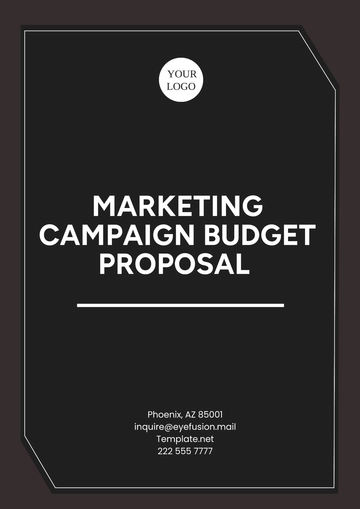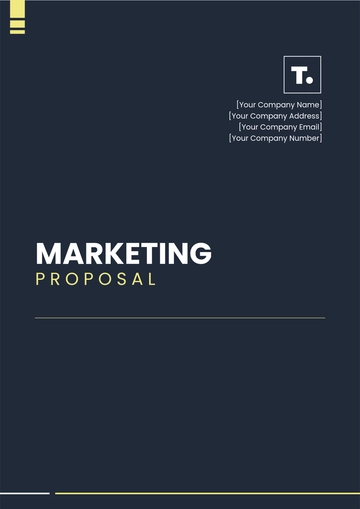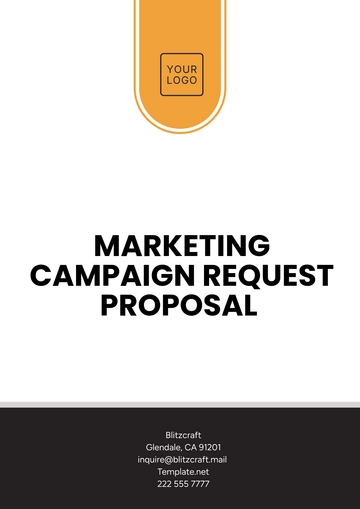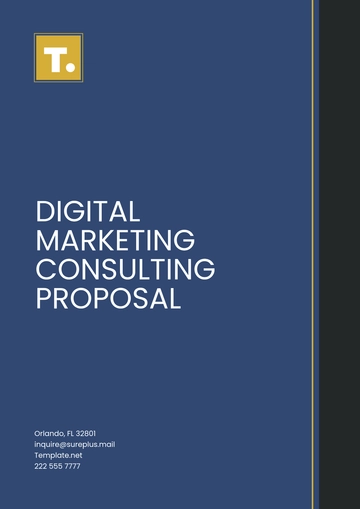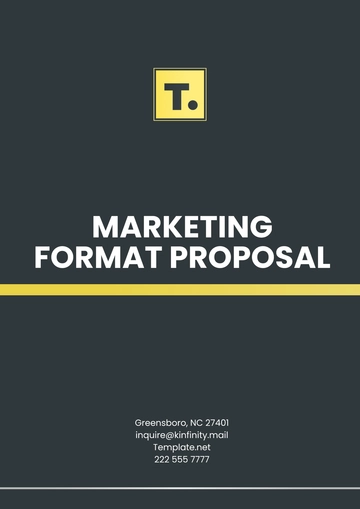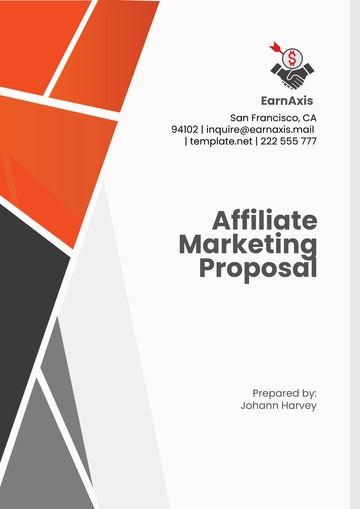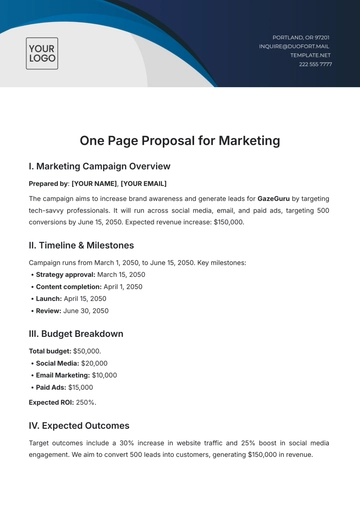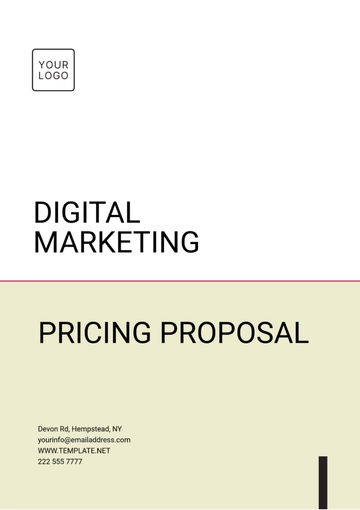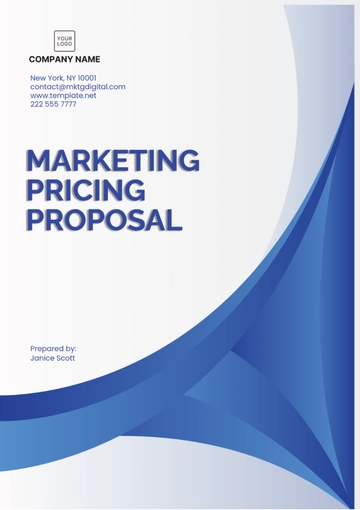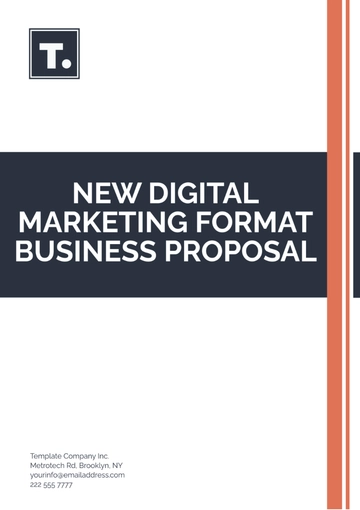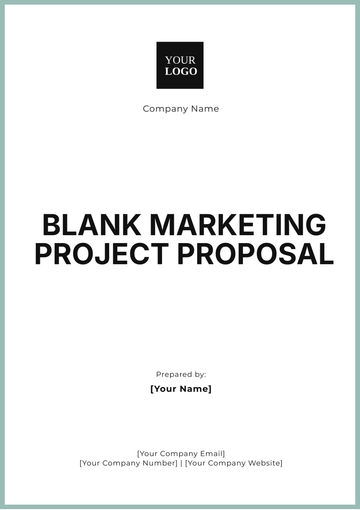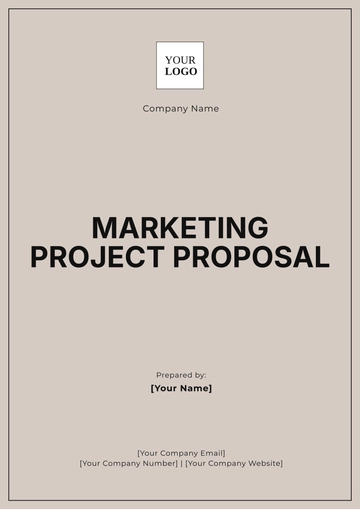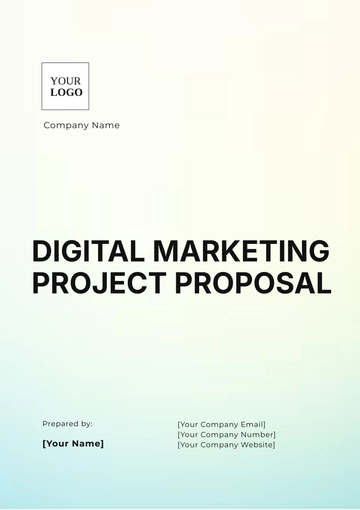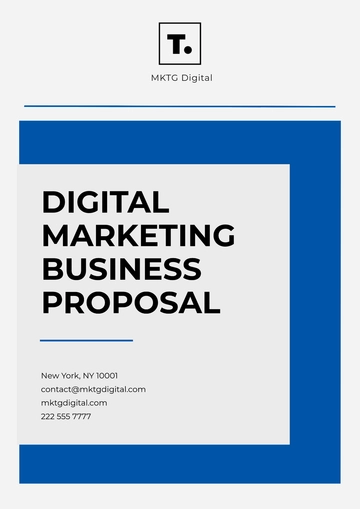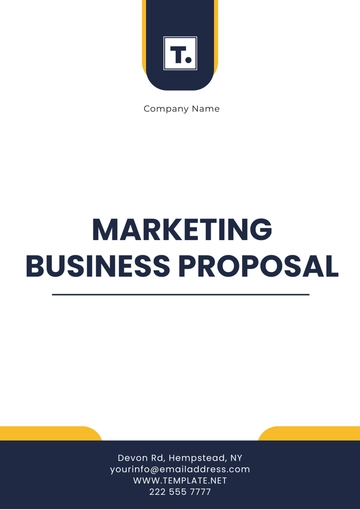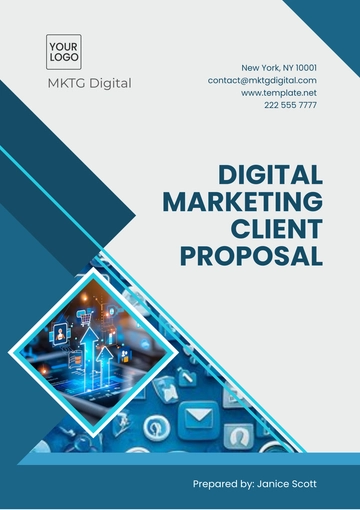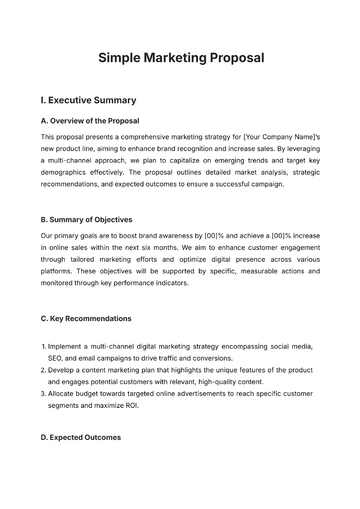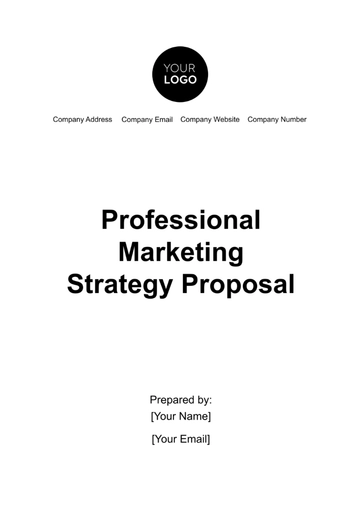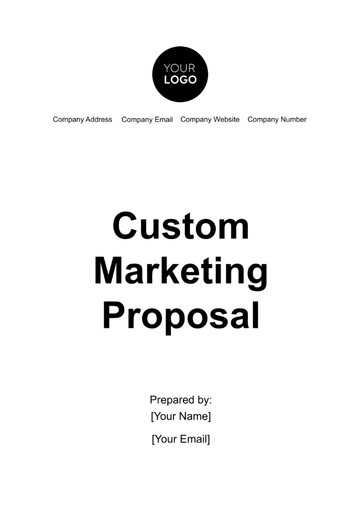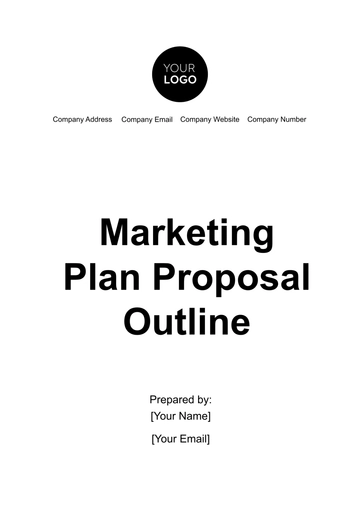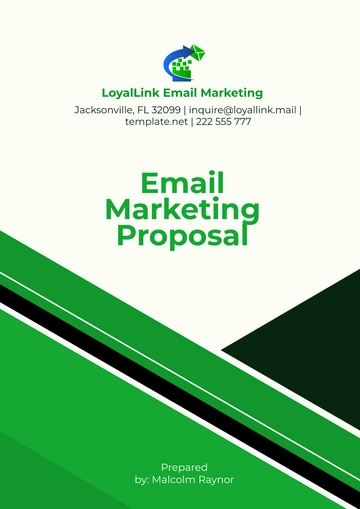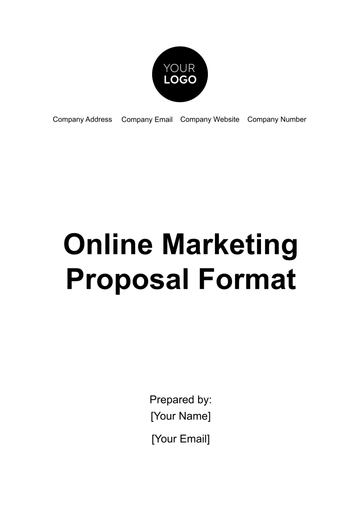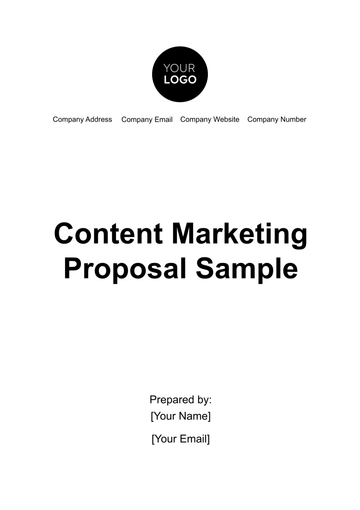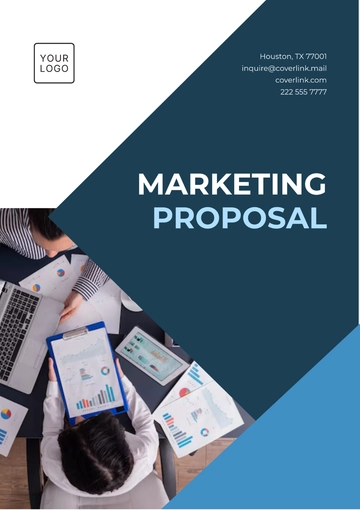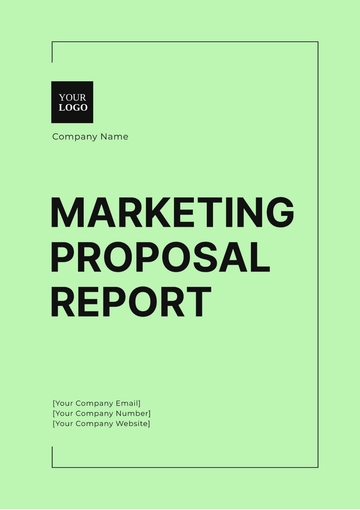Free Professional Marketing Strategy Proposal
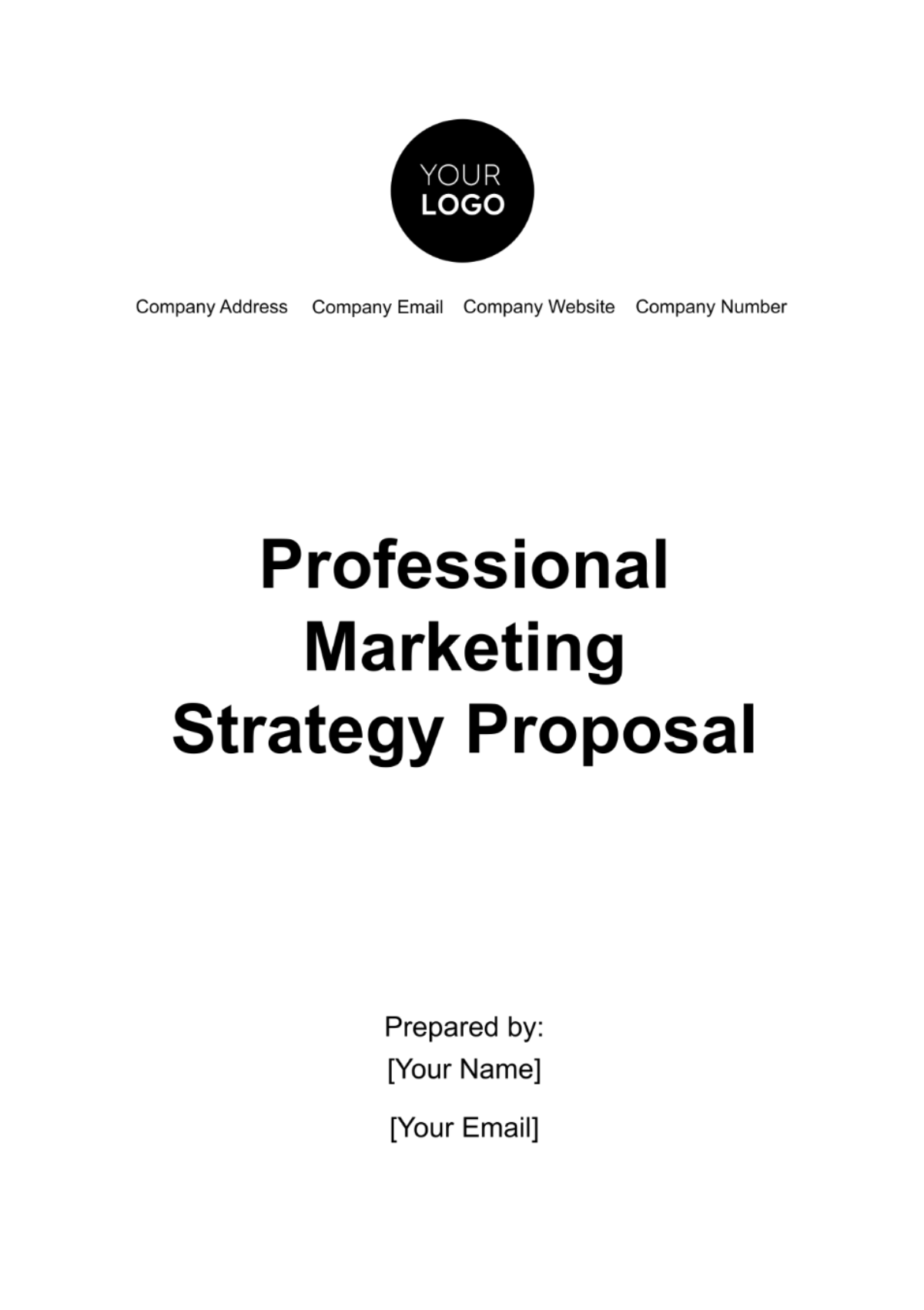
I. Executive Summary
A. Overview of the Proposal
This proposal outlines a strategic marketing plan aimed at elevating [Your Company Name]'s market position and driving substantial growth. By integrating innovative digital strategies with proven traditional methods, we seek to create a balanced approach that maximizes reach and engagement. The proposal includes actionable tactics designed to address current market challenges and capitalize on emerging opportunities.
B. Key Objectives and Goals
Our primary objective is to increase brand awareness by [00]% within the next year through targeted marketing campaigns and strategic initiatives. We also aim to boost website traffic by [00]% and enhance lead generation by [00]% by leveraging advanced digital tools and content marketing. Achieving these goals will position [Your Company Name] for long-term success and competitive advantage.
C. Summary of Recommended Strategies
We recommend implementing a comprehensive content marketing strategy that includes blog posts, case studies, and whitepapers to establish thought leadership. A robust social media campaign will be launched to engage with our target audience and build brand loyalty. Additionally, we propose investing in influencer partnerships and optimizing digital advertising efforts to drive measurable results.
II. Market Analysis
A. Industry Overview
The marketing industry is undergoing rapid transformation due to technological advancements and shifting consumer behaviors. Digital marketing, including social media and content marketing, has become increasingly dominant, while traditional methods still hold value in certain segments. Staying abreast of these changes is crucial for developing effective strategies and maintaining a competitive edge.
B. Market Trends
Key trends include the growing importance of data-driven marketing, where businesses use analytics to drive decision-making and measure performance. Personalization has become a significant focus, with consumers expecting tailored experiences and content. Additionally, the rise of new social media platforms and technologies presents both opportunities and challenges for reaching target audiences.
C. Competitive Analysis
Our primary competitors, [Competitor A] and [Competitor B], have established strong market positions with their extensive digital marketing efforts and innovative solutions. However, they lack a personalized approach and a deep understanding of specific customer needs, which can be leveraged to differentiate [Your Company Name]. By addressing these gaps, we can capture market share and position ourselves as a leader in the industry.
D. SWOT Analysis
Strengths | [Your Company Name] boasts a strong brand reputation, a diverse product portfolio, and an established market presence, providing a solid foundation for growth. |
Weaknesses | We face challenges such as limited expertise in digital marketing and a heavy reliance on traditional marketing channels, which may hinder our adaptability. |
Opportunities | There is a growing digital market with opportunities for personalized marketing, emerging social media platforms, and increasing demand for innovative solutions. |
Threats | We must contend with intense competition, rapid technological changes, and potential economic downturns that could impact market conditions. |
III. Target Audience
A. Customer Segmentation
Our target audience comprises professionals aged 25-45, with a particular focus on mid-level managers and decision-makers in the technology sector. We also aim to reach small business owners seeking innovative marketing solutions to drive their growth. Segmenting our audience allows us to tailor our marketing efforts to meet their specific needs and preferences.
B. Demographic and Psychographic Profiles
Demographic | Our ideal customers are predominantly college-educated, high-income earners, and tech-savvy individuals who value efficiency and innovation. |
Psychographic | They seek solutions that streamline business processes and are early adopters of new technology, reflecting a preference for cutting-edge solutions and personalized service. |
Lifestyle and Interests | They are interested in professional development, business growth, and staying ahead of industry trends, which influences their purchasing decisions. |
C. Customer Needs and Preferences
Our target audience values personalized service and high-quality products that offer actionable insights and measurable results. They prefer solutions that can be customized to fit their unique business needs and provide a clear ROI. Additionally, timely support and effective communication are critical factors in their decision-making process.
D. Buying Behavior
Customers conduct extensive research before making purchasing decisions, relying on online reviews, case studies, and peer recommendations. They prioritize cost-effectiveness and ROI, seeking solutions that provide clear and tangible benefits. Their buying behavior is influenced by brand reputation and the perceived value of the solutions offered.
IV. Marketing Goals and Objectives
A. Short-Term Goals
Increase social media followers by [00]% within the next six months to enhance brand visibility and engagement.
Launch a content marketing campaign aimed at generating 500 new leads within the next quarter by providing valuable and relevant content.
Improve website conversion rates by [00]% through targeted landing pages and optimized call-to-actions.
B. Long-Term Goals
Establish [Your Company Name] as a thought leader in the industry within the next 12 months by consistently publishing high-quality content and engaging with industry experts.
Achieve a [00]% increase in market share over the next two years through effective marketing strategies and competitive positioning.
Expand our customer base by [00]% by diversifying marketing channels and improving customer acquisition strategies.
C. Key Performance Indicators (KPIs)
Track website traffic, conversion rates, and lead generation to measure the effectiveness of marketing campaigns.
Monitor social media growth, engagement metrics, and follower interactions to assess the impact of our social media strategy.
Evaluate the cost per acquisition and return on investment (ROI) for various marketing activities to ensure optimal resource allocation and effectiveness.
V. Marketing Strategy
A. Positioning Strategy
[Your Company Name] will position itself as an industry leader in innovative marketing solutions, emphasizing our commitment to cutting-edge technology and personalized service. We aim to differentiate ourselves by offering tailored solutions that address specific business challenges and deliver measurable results. This positioning will be communicated through consistent messaging and targeted marketing efforts.
B. Unique Selling Proposition (USP)
Our USP lies in our ability to integrate advanced technology with a deep understanding of customer needs, providing unique and effective marketing solutions. Unlike competitors, we offer a highly customizable approach that adapts to the specific requirements of each client. This focus on personalization and innovation sets us apart and drives our competitive advantage.
C. Brand Messaging
Our brand messaging will highlight innovation, reliability, and a customer-centric approach, ensuring that our communication resonates with our target audience. We will emphasize our commitment to delivering cutting-edge solutions and exceptional service through all marketing channels. Consistent and engaging messaging will reinforce our brand identity and strengthen customer loyalty.
D. Value Proposition
[Your Company Name] offers unparalleled value through our innovative marketing tools and personalized approach, designed to drive business growth and enhance customer engagement. Our solutions are crafted to provide clear, actionable insights and deliver measurable results, addressing the unique needs of our clients. By choosing us, businesses gain access to a comprehensive marketing strategy that maximizes their impact and ROI.
VI. Tactical Plan
A. Product Strategy
Product Features and Benefits
Our products are designed with advanced features like real-time analytics and customizable dashboards, providing users with actionable insights and enhanced functionality. These benefits include improved marketing efficiency, better decision-making capabilities, and a more streamlined user experience.
Product Differentiation
We differentiate our products by offering unique integrations with leading industry tools and a user-friendly interface that sets us apart from competitors. Our focus on customization and scalability ensures that our solutions can adapt to various business needs and growth stages.
B. Pricing Strategy
Pricing Models
We will implement a tiered pricing model to accommodate different business sizes and needs, with basic, standard, and premium packages offering varying levels of features and support. This approach allows customers to select the option that best fits their requirements and budget.
Discounts and Offers
To attract new customers and incentivize long-term commitments, we will offer promotional discounts and limited-time offers. These promotions will be strategically timed to align with key business milestones and market opportunities.
C. Distribution Strategy
Channels of Distribution
Our products will be distributed through multiple channels, including direct sales via our website and partnerships with key industry resellers. We will also explore opportunities with affiliate networks and online marketplaces to broaden our reach.
Logistics and Supply Chain
We will optimize our logistics and supply chain processes by partnering with reliable fulfillment centers and using advanced tracking systems. This ensures timely delivery, efficient inventory management, and a seamless customer experience.
D. Promotion Strategy
Advertising Campaigns
We will launch targeted advertising campaigns on platforms such as Google Ads and LinkedIn to reach our key audience segments effectively. These campaigns will be optimized based on performance data to maximize ROI and engagement.
Public Relations
Our PR efforts will focus on securing media coverage in relevant industry publications and building relationships with journalists and influencers. By enhancing our media presence, we aim to strengthen our brand credibility and reach a wider audience.
Social Media Marketing
A strategic social media campaign will be developed to engage with our audience across platforms like LinkedIn, Twitter, and Facebook. We will create compelling content and leverage social media analytics to track performance and refine our approach.
Content Marketing
Our content marketing strategy will include the production of high-quality blog posts, whitepapers, and case studies to provide valuable insights and drive lead generation. This content will be tailored to address the needs and interests of our target audience.
Influencer Partnerships
We will collaborate with industry influencers to amplify our brand message and reach potential customers through authentic endorsements. These partnerships will be carefully selected to align with our brand values and target audience.
VII. Budget and Resource Allocation
A. Budget Overview
The total marketing budget of $[00] will be allocated across various channels and activities to ensure a balanced and effective strategy. This budget is designed to support both immediate initiatives and long-term goals.
B. Resource Allocation
Resources will be strategically distributed to key areas, including digital advertising, content creation, and social media marketing, with a focus on maximizing impact and efficiency. Adequate funding will also be set aside for PR activities and influencer partnerships.
C. Cost Breakdown
Digital Advertising | $[00] will be allocated to online ads and sponsored content to drive traffic and conversions. |
Content Creation | $[00] will be used for producing high-quality content, including articles, videos, and infographics. |
Social Media Marketing | $[00] will support the development and execution of social media campaigns. |
PR Activities | $[00] will be invested in media outreach and public relations efforts. |
Miscellaneous | $[00] will cover unexpected expenses and additional initiatives. |
D. Return on Investment (ROI) Analysis
ROI will be evaluated by comparing the cost of each marketing activity to the revenue and results generated. We aim for a [00]% ROI for digital advertising and a [00]% ROI for content marketing, with ongoing adjustments to optimize performance.
VIII. Implementation Plan
A. Timeline and Milestones
The implementation plan spans 12 months, with key milestones including the launch of advertising campaigns, content releases, and quarterly performance reviews. Each milestone will be carefully monitored to ensure timely execution and alignment with overall objectives.
B. Roles and Responsibilities
Marketing Manager | Oversee the execution of the strategy, coordinate activities, and ensure alignment with goals. |
Content Creator | Develop and manage content, ensuring it meets quality standards and aligns with the marketing strategy. |
Social Media Specialist | Handle social media campaigns, engage with followers, and track performance metrics. |
PR Coordinator | Manage public relations efforts, secure media coverage, and build relationships with industry influencers. |
C. Project Management
We will utilize project management tools to track progress, assign tasks, and ensure all marketing activities are completed on schedule. Regular status meetings and updates will be conducted to address any issues and keep the team aligned.
D. Risk Management
Potential risks include budget overruns, changes in market conditions, and delays in campaign execution. Contingency plans will be developed to address these risks, ensuring that the strategy remains on track and adaptable to unforeseen challenges.
IX. Measurement and Evaluation
A. Performance Metrics
We will track key metrics such as website traffic, conversion rates, and social media engagement to assess the effectiveness of our marketing activities. These metrics will provide insights into campaign performance and areas for improvement.
B. Monitoring and Reporting
Regular reports will be generated to review progress against goals and KPIs, with data analysis to identify trends and opportunities. These reports will be used to make data-driven decisions and refine strategies as needed.
C. Adjustments and Optimization
Based on performance data, we will make adjustments to optimize marketing efforts, including refining targeting, enhancing content, and reallocating resources. Continuous optimization will ensure that our strategies remain effective and responsive to market changes.
D. Success Criteria
Success will be determined by achieving the outlined marketing goals, meeting KPIs, and demonstrating a positive impact on overall business growth. We will also assess the effectiveness of each marketing channel and strategy to ensure continued success.
X. Conclusion
A. Summary of Key Points
This proposal presents a detailed marketing strategy designed to enhance [Your Company Name]’s market position and drive growth. By integrating innovative tactics with a clear focus on goals and metrics, we aim to achieve significant improvements in brand visibility and customer engagement.
B. Final Recommendations
We recommend proceeding with the proposed strategy, emphasizing the importance of digital marketing, content creation, and strategic partnerships. Implementing these recommendations will position [Your Company Name] for success and long-term growth.
C. Next Steps
The next steps involve finalizing the budget, assembling the marketing team, and initiating the implementation phase according to the outlined timeline. Regular reviews and adjustments will be made to ensure the strategy remains aligned with our objectives and adapts to evolving market conditions.
- 100% Customizable, free editor
- Access 1 Million+ Templates, photo’s & graphics
- Download or share as a template
- Click and replace photos, graphics, text, backgrounds
- Resize, crop, AI write & more
- Access advanced editor
Optimize your marketing strategy with the Professional Marketing Strategy Proposal Template from Template.net. This fully editable and customizable template offers a seamless experience with our advanced AI Editor Tool, allowing you to tailor every detail to your needs. Enhance your proposals with a professional touch and save time with this versatile, easy-to-use template.
You may also like
- Business Proposal
- Research Proposal
- Proposal Request
- Project Proposal
- Grant Proposal
- Photography Proposal
- Job Proposal
- Budget Proposal
- Marketing Proposal
- Branding Proposal
- Advertising Proposal
- Sales Proposal
- Startup Proposal
- Event Proposal
- Creative Proposal
- Restaurant Proposal
- Blank Proposal
- One Page Proposal
- Proposal Report
- IT Proposal
- Non Profit Proposal
- Training Proposal
- Construction Proposal
- School Proposal
- Cleaning Proposal
- Contract Proposal
- HR Proposal
- Travel Agency Proposal
- Small Business Proposal
- Investment Proposal
- Bid Proposal
- Retail Business Proposal
- Sponsorship Proposal
- Academic Proposal
- Partnership Proposal
- Work Proposal
- Agency Proposal
- University Proposal
- Accounting Proposal
- Real Estate Proposal
- Hotel Proposal
- Product Proposal
- Advertising Agency Proposal
- Development Proposal
- Loan Proposal
- Website Proposal
- Nursing Home Proposal
- Financial Proposal
- Salon Proposal
- Freelancer Proposal
- Funding Proposal
- Work from Home Proposal
- Company Proposal
- Consulting Proposal
- Educational Proposal
- Construction Bid Proposal
- Interior Design Proposal
- New Product Proposal
- Sports Proposal
- Corporate Proposal
- Food Proposal
- Property Proposal
- Maintenance Proposal
- Purchase Proposal
- Rental Proposal
- Recruitment Proposal
- Social Media Proposal
- Travel Proposal
- Trip Proposal
- Software Proposal
- Conference Proposal
- Graphic Design Proposal
- Law Firm Proposal
- Medical Proposal
- Music Proposal
- Pricing Proposal
- SEO Proposal
- Strategy Proposal
- Technical Proposal
- Coaching Proposal
- Ecommerce Proposal
- Fundraising Proposal
- Landscaping Proposal
- Charity Proposal
- Contractor Proposal
- Exhibition Proposal
- Art Proposal
- Mobile Proposal
- Equipment Proposal
- Student Proposal
- Engineering Proposal
- Business Proposal

